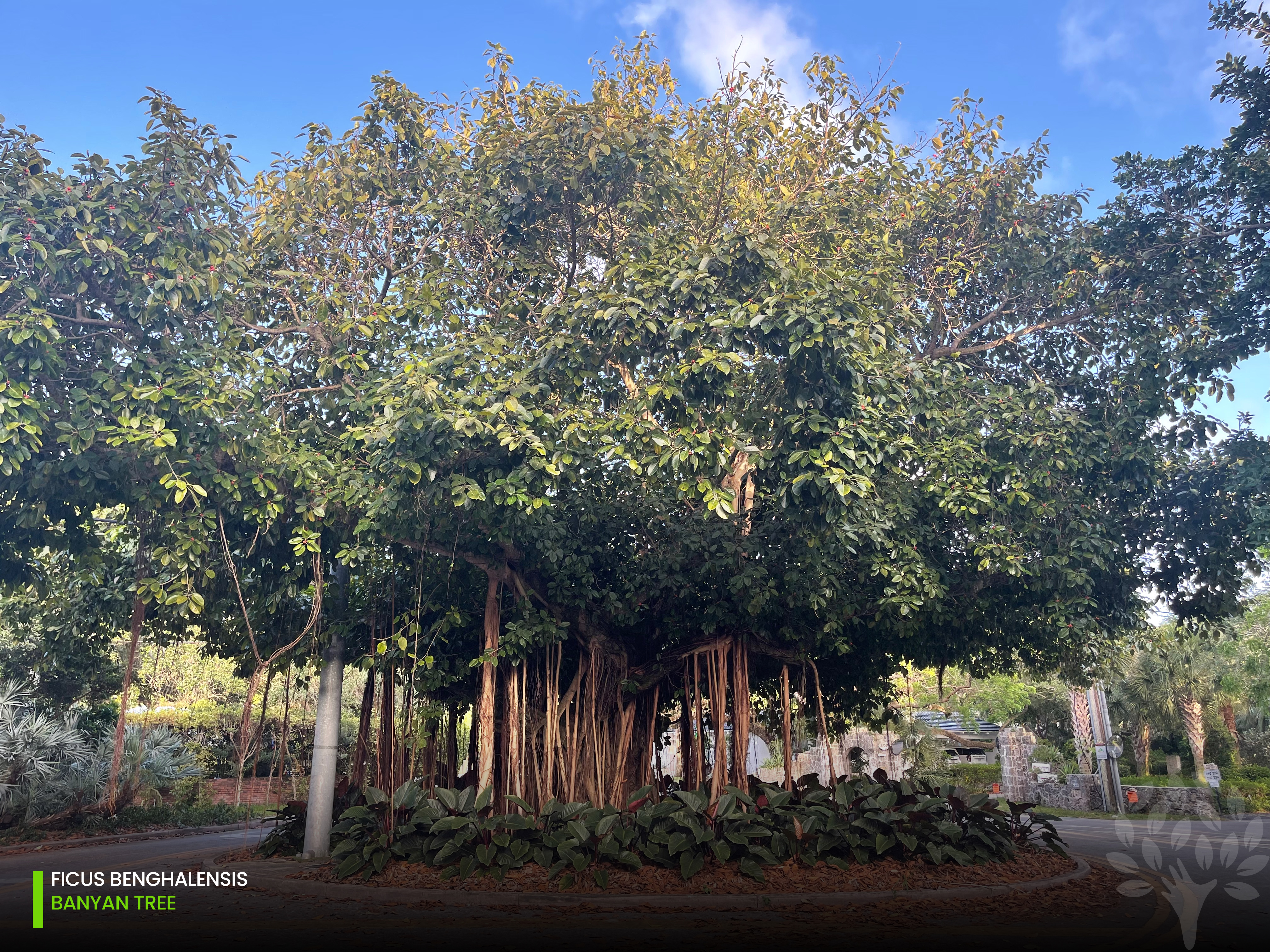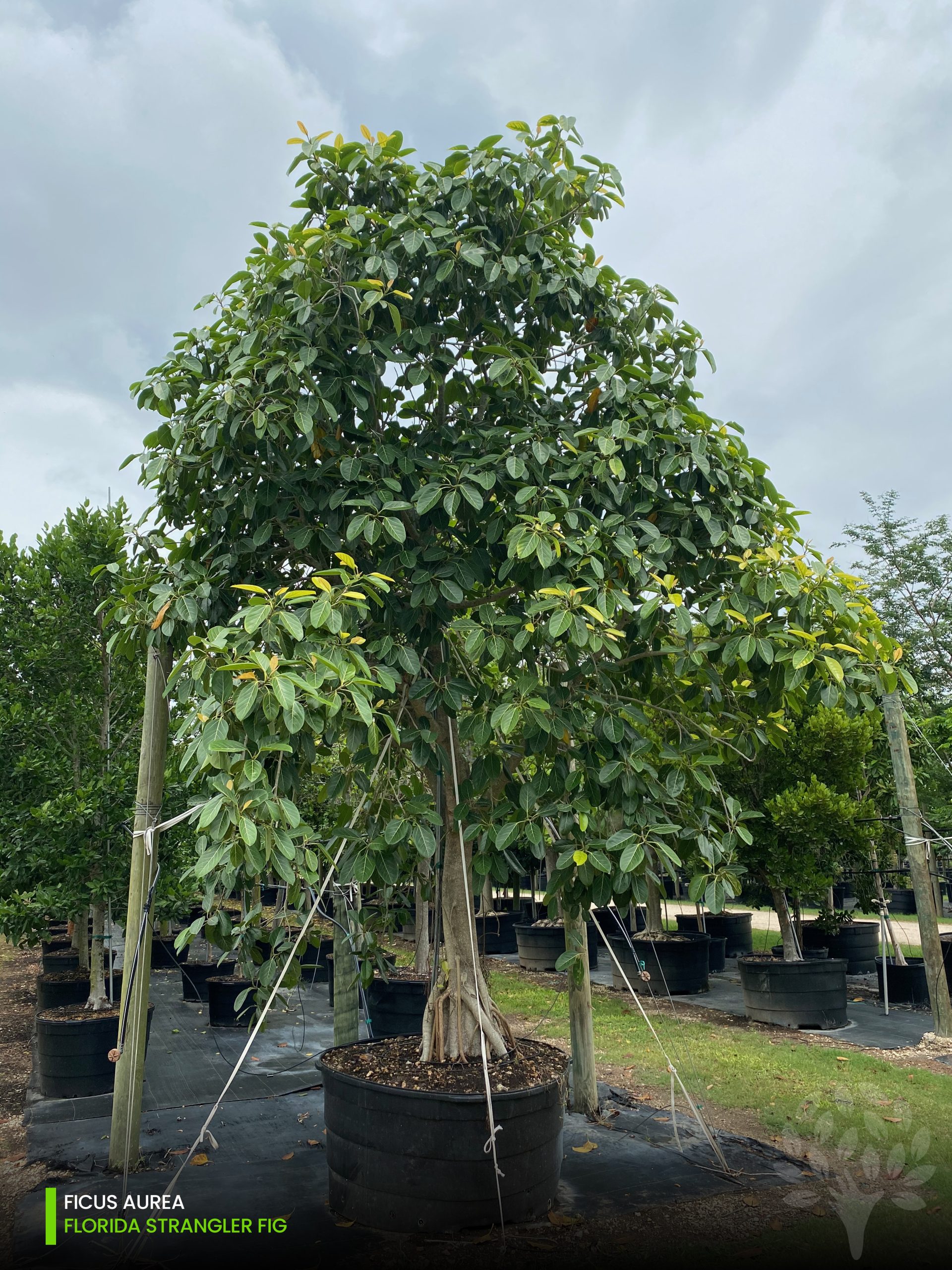Ficus trees have become increasingly popular in modern garden landscape design due to their versatility, adaptability, and aesthetic appeal. Ficus tree types like Ficus benghalensis, Ficus aurea, Ficus rubiginosa, and Ficus religiosa are in high demand in South Florida for several reasons. Including their tolerance to a variety of soil and environmental conditions, their ability to provide screening, and their unique beauty.
What does a ficus tree look like?
One of the main attractions of ficus trees is their striking appearance. Many ficus species have attractive, glossy leaves that provide a vibrant, lush look to landscapes. Additionally, their impressive size and sprawling canopies make them ideal for use as shade trees or to create privacy barriers.
Ficus trees can be used in a wide variety of ways in the landscape. They can be used in mixed-species plantings, used to line roadways or property boundaries, or planted as single specimens. The dramatic aerial roots of the banyan tree (Ficus benghalensis), which can add an additional level of interest to a landscape, are one of the reasons for its popularity. The amazing size, unusual growth pattern, and lovely foliage of the Florida Strangler Fig (Ficus aurea) set it apart from other trees. And the distinctive colors, shapes, and textures of the rusty fig (Ficus rubiginosa) and sacred fig (Ficus religiosa) set them apart as great options.
Adaptability in the South Florida landscape
These naturally stunning trees have become important elements for the knowledgeable landscapers and arborists that are able to maintain and work with them. Besides, ficus trees are a great fit for South Florida for several reasons.
First of all, they are tolerant of a range of soil and environmental conditions, which is crucial in an area with a humid, subtropical climate that occasionally suffers hurricanes, high temperatures, and rainfall. Besides, due to their versatility, ficus trees may thrive in various types of soil conditions. From sandy to clayey, and they can withstand dry spells.
Secondly, the impressive size and sprawling canopies of many ficus tree types make them ideal for use as shade trees or to create privacy barriers. Which is important in a region where the hot sun can be intense and privacy is valued. Lastly, ficus trees are also attractive and can add visual interest to a landscape. Their unique shapes, handsome foliage, and impressive characteristics make them popular as accent trees or focal points in modern landscape designs.
Different Types of Ficus Trees
How many types of ficus trees are there? As part of our commitment to the landscape at TreeWorld, we have hundreds of species of trees in our nursery. Including an important selection of Ficus trees that we can guarantee, thanks to our research, are suitable for the South Florida and Caribbean landscape. The Ficus tree types include:
Banyan Tree (Ficus benghalensis)
Due to its outstanding size, adaptability, and distinctive appearance, Ficus benghalensis, also known as the Banyan tree, is a fantastic option for landscape design projects in Florida and the Caribbean. The height of this tree can reach 100 feet, and its spread can be up to 300 feet wide. Its aerial roots give it a unique appearance that enhances its all-around aesthetic appeal. The banyan tree is a versatile option for all sorts of landscapes. Since it can thrive in a variety of soil and environmental conditions. The best way to use this type of ficus tree in a landscape is as a focal point in a spacious open area like a park or public garden.
Florida Strangler Fig (Ficus aurea)
Moreover, you can find the Ficus aurea, also known as the Florida Strangler Fig, in our inventory. This Florida native tree is an attractive option for landscape design projects. It is a hardy tree that is perfect for use in both residential and commercial settings. And can withstand a variety of soil types and weather conditions. The aerial roots of the Florida Strangler Fig can develop into enormous, woody trunks that wrap around the host tree. Giving it a remarkable and distinctive appearance. It looks more natural and organic when planted in groups. Or as an accent tree in landscape design.
Rusty Fig (Ficus rubiginosa)
Also, the rusty fig, or Ficus rubiginosa, is a stunning and resilient tree that is perfect for landscape design projects in the area. This ficus tree type adds beauty to any landscape with its glossy green leaves that attractively contrast with its rust-colored bark. It is a versatile choice for different kinds of landscapes. Because it can withstand a variety of soil types and environmental conditions. Besides, the rusty fig can be planted as an accent tree in a landscape or as a privacy screen.
Sacred Fig (Ficus religiosa)
Finally, the Ficus religiosa, or Sacred Fig, is also a popular choice for landscape design projects. Especially in the Caribbean, due to its unique cultural significance. It is considered a sacred tree in many cultures and is often planted near temples or other religious sites. This tree has a striking appearance, with heart-shaped leaves and a spreading canopy that provides ample shade. It can tolerate a range of soil types and environmental conditions. Making it a versatile choice for different types of landscapes. The Sacred Fig’s best landscape application is as a focal point or accent tree in a large open space. Such as a park or public garden.
Ficus Citrifolia (Short Leaf Fig) & Ficus Nitida (Indian Laurel)
The best ficus tree type for your landscape project!
Overall, the Banyan tree is ideal for large open spaces; the Florida Strangler Fig is well-suited for natural, organic landscapes; the Rusty Fig is great for adding aesthetic value to a property; and the Sacred Fig is best suited for landscapes that require cultural significance. Remember, it’s crucial to think about the unique qualities of each ficus tree type and how they fit into the overall plan for the landscape before selecting one.
























